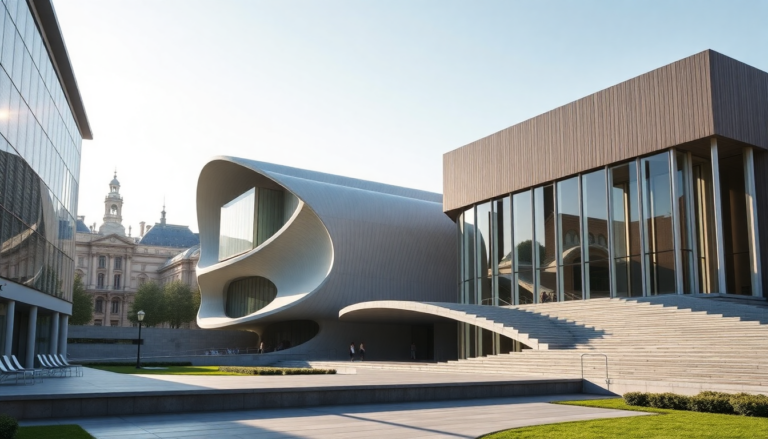Argomenti trattati
Amidst the vast array of museums around the globe lies a treasure trove of history, artistry, and innovation. Each museum not only houses ancient artifacts and breathtaking masterpieces but in many cases, the very buildings themselves are architectural marvels that deserve recognition. This is where the Prix Versailles comes into play—a prestigious award that celebrates extraordinary architecture and design. Recently, the award committee unveiled the seven most architecturally stunning museums for 2025, showcasing a blend of creativity and cultural significance.
Grand Palais, Paris
One of the standout winners is the Grand Palais in Paris, a Beaux-Arts masterpiece that masterfully intertwines classical elegance with modern design. Nestled along the iconic Champs-Élysées, this architectural gem was originally constructed for the 1900 Exposition Universelle. Its grandeur is not just a relic of the past; a recent extensive renovation led by Chatillon Architectes has introduced a magnificent 17,500 m² glass roof that floods the interior with natural light. This transformation has turned the Grand Palais into a vibrant hub of discovery, where art, innovation, and immersive experiences converge. The upper gallery, now beautifully restored, elegantly connects the museum’s storied past with its dynamic future, inviting visitors to engage with art in a way that feels both historic and contemporary.
Saka Museum, Bali
In July 2024, the Saka Museum opened its doors in the luxurious Ayana Estate complex on Bali’s Jimbaran Bay. This museum was selected for its unique ability to transform luxury into a cultural experience. Designed by Mitsubishi Jisho Design, it reflects the Balinese philosophy of Giri Segara, signifying the sacred balance between mountain and sea. The museum’s sloping roof visually links the natural landscapes, while a surrounding lake mirrors the shifting moonlight, creating an introspective atmosphere. Inside, visitors can explore archival documents and historical artifacts, while exhibitions celebrate Bali’s living traditions, including the contemplative philosophy of Nyepi, the Balinese Day of Silence. It’s more than just a museum; it’s a journey into the heart of Balinese culture.
Audeum, South Korea
Audeum, located in South Korea, has been recognized for its immersive sensory experience where architecture, nature, and perception intertwine seamlessly. Designed by the renowned Japanese architect Kengo Kuma, this museum encourages visitors to engage their senses—sight, sound, smell, and touch—making the connection to nature palpable. The exterior features a striking façade of vertical aluminum tubes, symbolizing the delicate balance between order and chaos found in natural ecosystems. As you enter, the scent of cypress wood envelops you, inviting a deeper connection to the environment. It’s not merely a place to observe art; it’s an experience that stimulates all senses, creating a harmonious dialogue between the viewer and the surroundings.
Kunstsilo, Norway
In the coastal city of Kristiansand, Norway, Kunstsilo stands as a brilliant example of architectural and cultural regeneration. Once an industrial grain silo from the 1930s, this structure has been transformed by Mestres Wåge Arquitectes into a celebrated cultural center. With 3,300 m² of exhibition space over three floors, Kunstsilo now houses the largest collection of Nordic art in southern Norway. The building’s imposing silos capture natural light, creating an ethereal atmosphere within the museum. It evokes a sense of majesty and poetry, particularly highlighted by its monumental staircase that invites exploration and discovery. This transformation showcases how a piece of industrial history can evolve into a beacon of artistic expression.
Diriyah Art Futures, Saudi Arabia
Representing a blend of tradition and innovation, the Diriyah Art Futures museum in Riyadh, designed by the Roman firm Schiattarella Associati, marks the first museum in the Arabian Peninsula dedicated entirely to digital art. This remarkable space appears to rise organically from the earth, merging ancient techniques with modern digital solutions. The museum’s design creates an almost haunting effect, where the structure becomes an integral part of the artwork, challenging the traditional boundaries between exhibition space and art itself. Inside, you’ll find galleries, research labs, artist residency programs, and an auditorium, all designed to create a seamless integration of urban and agricultural elements of the Wadi Hanifah landscape.
Cleveland Museum of Natural History, Ohio
The Cleveland Museum of Natural History has garnered recognition for its perfect harmony of contemporary architecture and natural history. Designed by DLR Group, the museum’s structure is inspired by the glacial landscapes of the Great Lakes region. It features flowing, white forms that mimic the region’s topographical contours, resulting in a cohesive design that unifies various sections of the museum. Located in a picturesque landscaped park, the museum tells the story of life on Earth, with its Visitor Hall showcasing the most iconic specimens. It’s a beautiful blend of nature and architecture that educates and inspires.
Joslyn Art Museum, Omaha
Finally, the Joslyn Art Museum in Omaha, Nebraska, exemplifies a fascinating interplay of history and modernity. Founded in 1931 to make art accessible to all, the museum captures millennia of human creativity and cultural richness. The complex now includes three remarkable buildings: the original 1931 Art Deco masterpiece by John and Alan McDonald, the Walter & Suzanne Scott Pavilion by Norman Foster from 1994, and the newest addition designed by the Norwegian firm Snøhetta, set to open in 2024. This juxtaposition of styles and eras creates a unique dialogue that reflects the complexities of American history while looking forward to future artistic endeavors. The Joslyn stands as a testament to the enduring power of art to transcend time and connect generations.
As we explore these architectural wonders, it becomes evident that museums are not merely repositories of artifacts; they are vibrant spaces that foster creativity, connection, and enlightenment. They remind us of our shared human experience and the beauty of our diverse cultures, all while inviting us to reflect on the past and envision the future.

